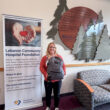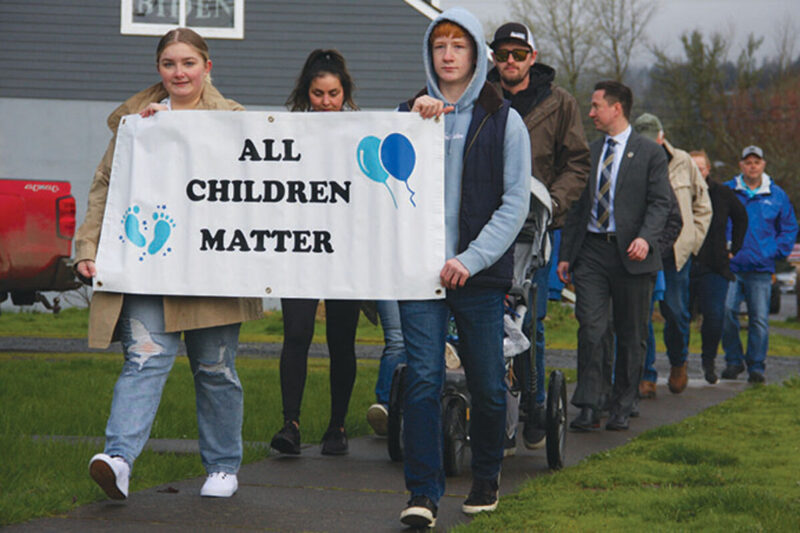Benny Westcott
About two dozen people participated Saturday morning, April 1, in the annual March for a Child along Main and Long streets.
The event kicked off Child Abuse Prevention Month.
Prior to the march, participants planted blue pinwheels outside the Sweet Home Police Department as part of a larger public initiative to turn Sweet Home blue, encouraging people to report suspicious circumstances and possible abuse.
ABC House, the children’s advocacy center for Linn and Benton counties, recorded its busiest year in 2022. The organization served 833 children: 633 from Linn County and 77 from Sweet Home. That’s an increase from 771 children in 2021 and 690 in 2020.
On a nationwide scale, according to the Center for Disease Control and Prevention, one in four girls and one in 10 boys will be the victim of child sexual abuse. About 15% of all children will be victimized.
Richard Wijers, a senior deputy district attorney with the Linn County District Attorney’s office, put that number in perspective at the march.
“Think about learning that the most vulnerable population amongst us, 15% of children, were suffering from a disease as we knew it, like an illness,” he said. “Think about the community response and government intervention that would happen to eradicate that. So how come it’s not the same for child abuse?”
“We’re not catching all of them,” he continued, noting that cases are difficult to detect. “We’re catching some of them.”
Cases often occur in the most isolated of situations.
“Sometimes only the abuser and the victim are witnesses to the crime,” he said. “As a result of that, these children often disclose well after the abuse occurs.”
He added that children were sometimes afraid to report because they didn’t know the possible repercussions. Shame was also a factor. Some also lacked the means to tell an adult, and others were such a part of an abusive culture that they knew nothing else.
“Unfortunately, in many of these situations, other guardians or adults in kids’ lives have misplaced priorities,” he said, “or they’re in a situation where they’re subject to the exact same pressures that prevent the children from disclosing. That tells us that we’re not doing enough for these children to feel empowered to come out and talk about their story, to tell an adult about what’s happening. Right now, we’re not doing enough to present to them that we are a safe space for them to come and disclose.”
Wijers believed that success against child abuse meant supporting community members engaged in the battle: law enforcement, child advocacy centers, foster parents, Department of Human Services workers, court appointed special advocates and judges.
“We need judges that are not scared to lay down the stiff and just penalties that these crimes deserve,” he said. “We need judges who are open to give a safe space for the victims to feel empowered to talk in the courtroom.”
He also stressed vigilance.
“We all need to be the good parents and community members that we are,” he said. “Anytime that we intersect with children, we have to have an eye for their safety. If you’re ever in a position where you might question whether a child is safe, don’t be afraid to report it to somebody, because it’s their job to check into it.”
According to ABC House Development Director Glenda Lonstron, the recent pandemic was likely a factor in the increased number of children served.
“We know this is due at least in part to children being isolated from a support system that might otherwise have intervened in their abuse,” she said. “The truth is we will likely not fully understand the impact the pandemic has had on the lives of children and teens, and we won’t for a long time to come.”
She noted that child abuse was a widespread public health issue across all demographics.
“The short and long term physical, mental and emotional impacts of victimization can be devastating for children, families, and communities,” she said.
Lonstron called the epidemic pervasive and relentless, arguing that the response must also be relentless.
“Everyone has a role to play, whether you’re a stay-at-home parent, a grandparent, an educator, a youth serving an individual, a first responder or a business owner,” she said. “We can make an impact. And the key to move beyond awareness into prevention is through education.
“You likely know a teen or child that has been abused or is vulnerable to abuse. That child is counting on you to learn the facts about child abuse, be prepared to take risks to intervene as an active bystander, talk to them about personal safety, boundaries and consent, recognize the signs of abuse, and provide caring trauma-informed support if they open up to you about their experience.”
She encouraged everyone present to attend a free ABC House training, whether it be school-based or for adults.
“Your call to action today is to think about a group that you’re a part of, and reach out to ABC House to schedule one of these trainings,” she said. “This small step may be the most critical step you take for a child in crisis who is waiting for you to take action. Showing up is the first step, and each person here today is taking a stand against child abuse and neglect.”
See more photos in our online gallery.





